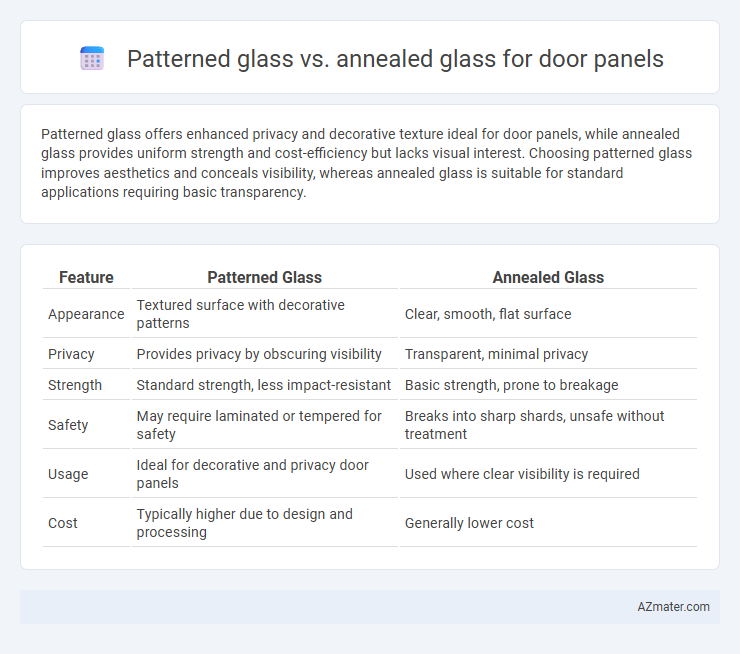Patterned glass offers enhanced privacy and decorative texture ideal for door panels, while annealed glass provides uniform strength and cost-efficiency but lacks visual interest. Choosing patterned glass improves aesthetics and conceals visibility, whereas annealed glass is suitable for standard applications requiring basic transparency.
Table of Comparison
| Feature | Patterned Glass | Annealed Glass |
|---|---|---|
| Appearance | Textured surface with decorative patterns | Clear, smooth, flat surface |
| Privacy | Provides privacy by obscuring visibility | Transparent, minimal privacy |
| Strength | Standard strength, less impact-resistant | Basic strength, prone to breakage |
| Safety | May require laminated or tempered for safety | Breaks into sharp shards, unsafe without treatment |
| Usage | Ideal for decorative and privacy door panels | Used where clear visibility is required |
| Cost | Typically higher due to design and processing | Generally lower cost |
Introduction to Door Panel Glass Options
Patterned glass offers textured surfaces that enhance privacy and increase visual interest, making it ideal for decorative door panels. Annealed glass is a standard flat glass treated through a controlled cooling process to reduce internal stress but lacks the texture and privacy benefits of patterned glass. Choosing between patterned and annealed glass for door panels depends on the desired balance of aesthetics, privacy, and safety.
What is Patterned Glass?
Patterned glass is a type of textured glass featuring embossed designs or patterns that provide visual privacy while allowing light to pass through, making it ideal for door panels. Unlike annealed glass, which is simply cooled slowly to remove internal stresses and maintains a smooth, transparent surface, patterned glass enhances aesthetics and obscures visibility. This glass is commonly used in residential and commercial doors to combine functionality with decorative appeal.
What is Annealed Glass?
Annealed glass is a standard form of glass that is slowly cooled to relieve internal stresses, resulting in a smooth, clear, and flat surface ideal for door panels. This type of glass is less expensive but more prone to breakage compared to tempered or laminated glass, making safety considerations crucial in its application. Patterned glass offers decorative textures and obscured visibility, whereas annealed glass prioritizes clarity and structural simplicity in door panel use.
Visual Appeal: Patterned vs Annealed Glass
Patterned glass enhances door panel visual appeal by offering textured designs that obscure visibility while allowing light diffusion, creating privacy with decorative aesthetics. Annealed glass provides a clear, smooth surface that maximizes transparency and natural light but lacks the ornamental texture seen in patterned variants. Choosing patterned glass emphasizes style and privacy, whereas annealed glass highlights simplicity and brightness.
Privacy Considerations
Patterned glass offers enhanced privacy for door panels by obscuring clear visibility while still allowing natural light to pass through, making it ideal for areas where confidentiality is important. Annealed glass, being transparent and untreated, provides minimal privacy and is typically used where visibility is preferred or privacy is managed through additional treatments like curtains or blinds. For privacy-focused door panels, patterned glass significantly reduces the risk of exposure compared to standard annealed glass.
Strength and Safety Differences
Patterned glass for door panels offers enhanced privacy and decorative appeal but generally has lower impact resistance compared to annealed glass. Annealed glass, while stronger than patterned glass due to its uniform cooling process, is more prone to shattering into sharp shards upon breakage, posing higher safety risks. Tempered or laminated treatments are often recommended for both glass types to improve strength and reduce injury hazards in door panel applications.
Energy Efficiency and Insulation
Patterned glass for door panels offers enhanced privacy while maintaining moderate thermal insulation, contributing to energy efficiency by diffusing light and reducing solar heat gain. Annealed glass, lacking specialized texture, provides basic insulation properties but often requires additional treatments or laminates to achieve similar energy performance levels. Choosing patterned glass can improve indoor temperature regulation and reduce energy consumption in heating and cooling compared to standard annealed glass.
Cost Comparison and Value
Patterned glass generally costs more than annealed glass due to its decorative textures and enhanced privacy features, making it a popular choice for door panels that combine aesthetics with functionality. Annealed glass is more affordable and offers basic durability and clarity but lacks the design versatility and privacy benefits of patterned glass. Choosing patterned glass for door panels maximizes value by providing both stylish appeal and daily practical advantages, justifying the higher initial investment through improved overall utility.
Maintenance and Durability
Patterned glass offers enhanced privacy and surface texture that helps conceal fingerprints and smudges, making it easier to maintain for door panels compared to smooth annealed glass. Annealed glass provides higher structural integrity and better resistance to pressure but is prone to scratches and shows dirt more visibly, requiring frequent cleaning to maintain clarity. Both types benefit from regular cleaning with non-abrasive materials, but patterned glass generally reduces visible wear and tear over time, improving long-term durability in high-traffic areas.
Choosing the Best Glass for Your Door Panel
Patterned glass offers enhanced privacy and decorative appeal for door panels, featuring textured surfaces that obscure visibility while allowing natural light to pass through. Annealed glass, known for its strength and safety, is a standard clear glass cooled slowly to reduce internal stresses, making it less prone to breakage. When choosing the best glass for your door panel, consider patterned glass for aesthetic and privacy needs, while annealed glass suits applications requiring clarity and structural integrity.

Infographic: Patterned glass vs Annealed glass for Door panel
 azmater.com
azmater.com